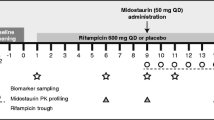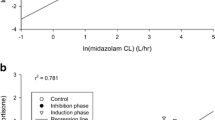Abstract
Purpose
To examine the effect of the fluoroquinolone DX-619 on CYP3A4 and urinary excretion of 6β-hydroxycortisol, an endogenous probe of hepatic CYP3A4 activity, in healthy subjects.
Methods
The effect of DX-619 on CYP3A4 was examined in human liver microsomes. The apparent formation and renal clearance of 6β-hydroxycortisol (CL6β−OHF and CLrenal,6β−OHF, respectively) were determined in placebo- and DX-619-treated subjects. 6β-hydroxycortisol uptake was determined in HEK293 cells expressing OAT1, OAT3, OCT2, MATE1, and MATE2-K.
Results
DX-619 was a mechanism-based inhibitor of CYP3A4, with KI and kinact of 67.9 ± 7.3 μmol/l and 0.0730 ± 0.0033 min−1, respectively. Pharmacokinetic simulation suggested in vivo relevance of CYP3A4 inhibition by DX-619. CL6β−OHF and CLrenal,6β−OHF were decreased 72% and 70%, respectively, on day 15 in DX-619-treated group compared with placebo (P < 0.05). 6β-hydroxycortisol was a substrate of OAT3 (Km = 183 ± 25 μmol/l), OCT2, MATE1, and MATE2-K. Maximum unbound concentration of DX-619 (9.1 ± 0.4 μmol/l) was above Ki of DX-619 for MATE1 (4.32 ± 0.79 μmol/l).
Conclusions
DX-619 caused a moderate inhibition of hepatic CYP3A4-mediated formation and significant inhibition of MATE-mediated efflux of 6β-hydroxycortisol into urine. Caution is needed in applying CL6β−OHF as an index of hepatic CYP3A4 activity without evaluating CLrenal,6β−OHF.






Similar content being viewed by others
Abbreviations
- 6β-OHF:
-
6β-hydroxycortisol
- AUC:
-
area under the concentration-time curve
- BBM:
-
brush border membrane
- Cmax :
-
maximum plasma concentration
- CYP:
-
cytochrome P450
- ES:
-
estrone-3-sulfate
- HEK:
-
human embryonic kidney
- HLM:
-
human liver microsomes
- kdeg :
-
degradation rate constant (turnover rate constant) of liver CYP3A4
- MRM:
-
multiple reaction monitoring
- PAH:
-
para-aminohippuric acid
- TEA:
-
tetraethylammonium
References
Honig PK, Wortham DC, Zamani K, Conner DP, Mullin JC, Cantilena LR. Terfenadine-ketoconazole interaction. Pharmacokinetic and electrocardiographic consequences. JAMA. 1993;269:1513–8.
Abel SM, Maggs JL, Back DJ, Park BK. Cortisol metabolism by human liver in vitro–I. Metabolite identification and inter-individual variability. J Steroid Biochem Mol Biol. 1992;43:713–9.
Peng CC, Templeton I, Thummel KE, Davis C, Kunze KL, Isoherranen N. Evaluation of 6beta-Hydroxycortisol, 6beta-Hydroxycortisone, and a Combination of the Two as Endogenous Probes for Inhibition of CYP3A4 In Vivo. Clin Pharmacol Ther. 2011;89:888–95.
de Wildt SN, Kearns GL, Leeder JS, van den Anker JN. Cytochrome P450 3A: ontogeny and drug disposition. Clin Pharmacokinet. 1999;37:485–505.
Saenger P. 6 beta-hydroxycortisol in random urine samples as an indicator of enzyme induction. Clin Pharmacol Ther. 1983;34:818–21.
Bienvenu T, Rey E, Pons G, d’Athis P, Olive G. A simple non-invasive procedure for the investigation of cytochrome P-450 IIIA dependent enzymes in humans. Int J Clin Pharmacol Ther Toxicol. 1991;29:441–5.
Furuta T, Suzuki A, Mori C, Shibasaki H, Yokokawa A, Kasuya Y. Evidence for the validity of cortisol 6 beta-hydroxylation clearance as a new index for in vivo cytochrome P450 3A phenotyping in humans. Drug Metab Dispos. 2003;31:1283–7.
Ushiama H, Echizen H, Nachi S, Ohnishi A. Dose-dependent inhibition of CYP3A activity by clarithromycin during Helicobacter pylori eradication therapy assessed by changes in plasma lansoprazole levels and partial cortisol clearance to 6beta-hydroxycortisol. Clin Pharmacol Ther. 2002;72:33–43.
Fujikawa K, Chiba M, Tanaka M, Sato K. In vitro antibacterial activity of DX-619, a novel des-fluoro(6) quinolone. Antimicrob Agents Chemother. 2005;49:3040–5.
Asif AR, Steffgen J, Metten M, Grunewald RW, Muller GA, Bahn A, et al. Presence of organic anion transporters 3 (OAT3) and 4 (OAT4) in human adrenocortical cells. Pflugers Arch. 2005;450:88–95.
Ueda K, Okamura N, Hirai M, Tanigawara Y, Saeki T, Kioka N, et al. Human P-glycoprotein transports cortisol, aldosterone, and dexamethasone, but not progesterone. J Biol Chem. 1992;267:24248–52.
Imamura Y, Murayama N, Okudaira N, Kurihara A, Okazaki O, Izumi T, et al. Prediction of fluoroquinolone-induced elevation in serum creatinine levels: a case of drug-endogenous substance interaction involving the inhibition of renal secretion. Clin Pharmacol Ther. 2011;89:81–8.
Watanabe A, Nakamura K, Okudaira N, Okazaki O, Sudo K. Risk assessment for drug-drug interaction caused by metabolism-based inhibition of CYP3A using automated in vitro assay systems and its application in the early drug discovery process. Drug Metab Dispos. 2007;35:1232–8.
Kanamitsu S, Ito K, Green CE, Tyson CA, Shimada N, Sugiyama Y. Prediction of in vivo interaction between triazolam and erythromycin based on in vitro studies using human liver microsomes and recombinant human CYP3A4. Pharm Res. 2000;17:419–26.
Lai AA, Levy RH, Cutler RE. Time-course of interaction between carbamazepine and clonazepam in normal man. Clin Pharmacol Ther. 1978;24:316–23.
Fromm MF, Busse D, Kroemer HK, Eichelbaum M. Differential induction of prehepatic and hepatic metabolism of verapamil by rifampin. Hepatology. 1996;24:796–801.
Hsu A, Granneman GR, Witt G, Locke C, Denissen J, Molla A, et al. Multiple-dose pharmacokinetics of ritonavir in human immunodeficiency virus-infected subjects. Antimicrob Agents Chemother. 1997;41:898–905.
Enomoto A, Takeda M, Taki K, Takayama F, Noshiro R, Niwa T, et al. Interactions of human organic anion as well as cation transporters with indoxyl sulfate. Eur J Pharmacol. 2003;466:13–20.
Matsushima S, Maeda K, Inoue K, Ohta KY, Yuasa H, Kondo T, et al. The inhibition of human multidrug and toxin extrusion 1 is involved in the drug-drug interaction caused by cimetidine. Drug Metab Dispos. 2009;37:555–9.
Ohta KY, Imamura Y, Okudaira N, Atsumi R, Inoue K, Yuasa H. Functional characterization of multidrug and toxin extrusion protein 1 as a facilitative transporter for fluoroquinolones. J Pharmacol Exp Ther. 2009;328:628–34.
Smith AJ, Mayer U, Schinkel AH, Borst P. Availability of PSC833, a substrate and inhibitor of P-glycoproteins, in various concentrations of serum. J Natl Cancer Inst. 1998;90:1161–6.
Kodaira H, Kusuhara H, Ushiki J, Fuse E, Sugiyama Y. Kinetic analysis of the cooperation of P-glycoprotein (P-gp/Abcb1) and breast cancer resistance protein (Bcrp/Abcg2) in limiting the brain and testis penetration of erlotinib, flavopiridol, and mitoxantrone. J Pharmacol Exp Ther. 2010;333:788–96.
Waters NJ, Jones R, Williams G, Sohal B. Validation of a rapid equilibrium dialysis approach for the measurement of plasma protein binding. J Pharm Sci. 2008;97:4586–95.
Cho YS, Kim CH, Cheon HG. Cell-based assay for screening 11beta-hydroxysteroid dehydrogenase 1 inhibitors. Anal Biochem. 2009;392:110–6.
Brown RW, Chapman KE, Kotelevtsev Y, Yau JL, Lindsay RS, Brett L, et al. Cloning and production of antisera to human placental 11 beta-hydroxysteroid dehydrogenase type 2. Biochem J. 1996;313(Pt 3):1007–17.
Hasegawa M, Kusuhara H, Endou H, Sugiyama Y. Contribution of organic anion transporters to the renal uptake of anionic compounds and nucleoside derivatives in rat. J Pharmacol Exp Ther. 2003;305:1087–97.
Nozaki Y, Kusuhara H, Kondo T, Hasegawa M, Shiroyanagi Y, Nakazawa H, et al. Characterization of the uptake of organic anion transporter (OAT) 1 and OAT3 substrates by human kidney slices. J Pharmacol Exp Ther. 2007;321:362–9.
Otsuka M, Matsumoto T, Morimoto R, Arioka S, Omote H, Moriyama Y. A human transporter protein that mediates the final excretion step for toxic organic cations. Proc Natl Acad Sci U S A. 2005;102:17923–8.
Acknowledgments and Disclosures
The authors acknowledge Ryo Atsumi, for his contribution to the study design and interpretation of results.
Yuichiro Imamura, Nobuyuki Murayama, Noriko Okudaira, Ryo Atsumi, Atsushi Kurihara and Takashi Izumi are employees of Daiichi Sankyo Co., Ltd. Other authors declare no conflict of interest.
The study was sponsored by Daiichi-Sankyo Co., Ltd, Tokyo, Japan. This study was also supported by the Japan Health Sciences Foundation [Grants-in-Aid for Public-private sector joint research on Publicly Essential Drugs (KHB 1208)].
Author information
Authors and Affiliations
Corresponding author
Rights and permissions
About this article
Cite this article
Imamura, Y., Murayama, N., Okudaira, N. et al. Effect of the Fluoroquinolone Antibacterial Agent DX-619 on the Apparent Formation and Renal Clearances of 6β-Hydroxycortisol, an Endogenous Probe for CYP3A4 Inhibition, in Healthy Subjects. Pharm Res 30, 447–457 (2013). https://doi.org/10.1007/s11095-012-0890-6
Received:
Accepted:
Published:
Issue Date:
DOI: https://doi.org/10.1007/s11095-012-0890-6




